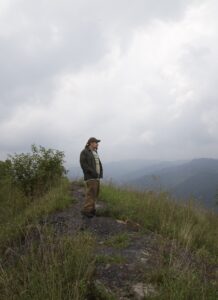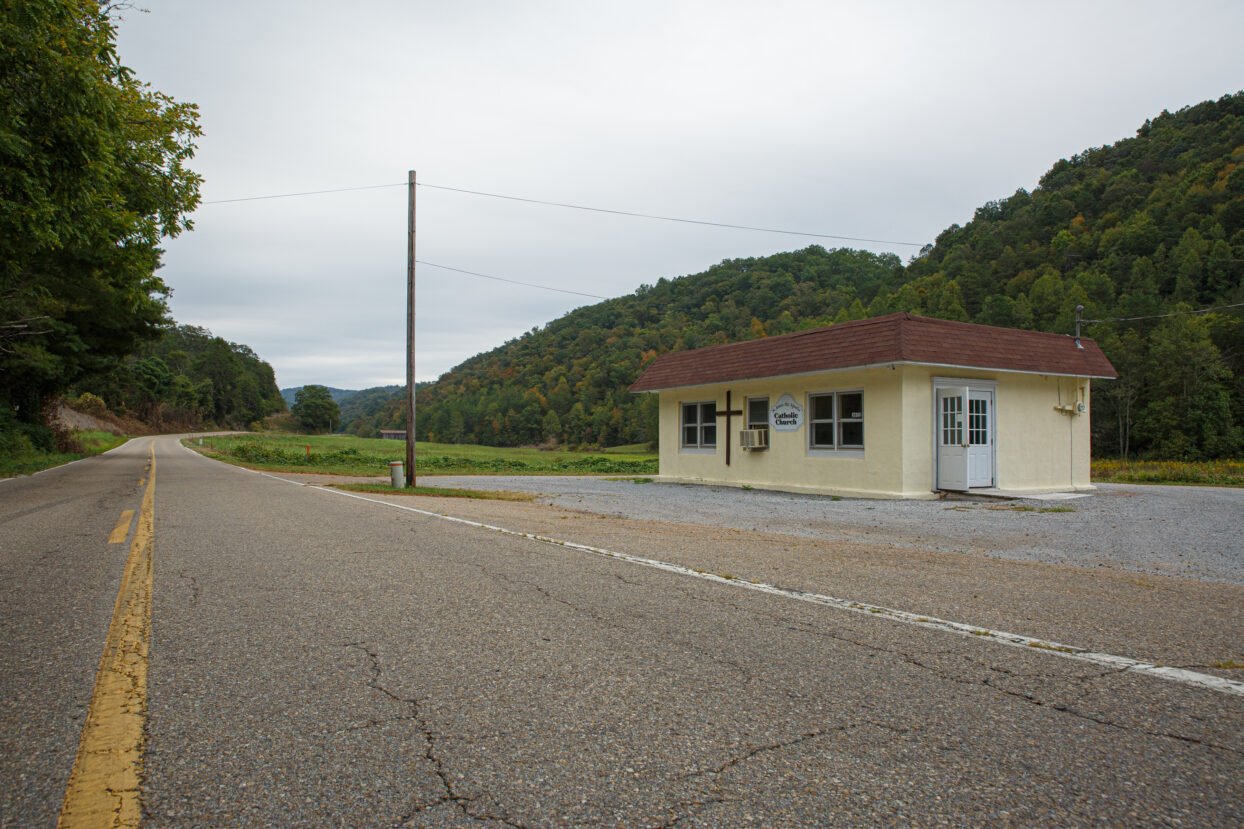Pastoral addresses region’s social, economic, environmental needs
By Emily Booker
From St. Francis of Assisi’s Canticle of Creation, which celebrates 800 years this year, to Pope Francis’ encyclical Laudato Si’, which marks 10 years in 2025, the Church has a long tradition of promoting the dignity of the human person, the care of creation, and God’s love for the poor.
It is in that tradition that “This Land is Home to Me,” a pastoral letter signed by 25 bishops in Appalachia, is celebrating its 50th anniversary this year. “This Land is Home to Me” addresses the history and needs of both people and land in Appalachia.
The idea to have a joint pastoral letter on the region came out of the work of the Catholic Committee of Appalachia (CCA). The CCA was formed in the 1960s as the Catholic caucus of CORA (Commission on Religion in Appalachia). With the federal formation of the Appalachian Regional Commission, there was a new focus on addressing the disproportionate poverty and resource needs in the region, which covers parts of 13 states.
The CCA worked with bishops of the region, which includes East Tennessee, to increase Church awareness of the characteristic issues that were unique to Appalachia. Even though Catholicism had a statistically small presence in the region, the bishops and the CCA hoped to make a large impact addressing the needs of the people.
In 1973, the CCA focused on the question “How can we, individually and corporately, work toward a more effective missionary presence of the Church in Appalachia?” The developed plan included a focus on proclaiming the Gospel message, identifying with the poor, clarifying ministerial roles within the Catholic community, demonstrating appreciation of Appalachian culture, and acknowledging the personal need for repentance.
Similar to the most recent Synod for Synodality, there was a desire to hear from a variety of voices and have the people’s experiences lead the discussion. The CCA interviewed individuals, community groups, and church workers. Their stories were incorporated in the pastoral, which was developed in cooperation with local bishops.
“This Land is Home to Me: A Pastoral Letter on Powerlessness in Appalachia” was signed by 25 bishops whose dioceses covered the Appalachian region. Their united voices gave weight to the document that addresses concerns over the economic and political struggles of the region, particularly in the coal country of central Appalachia.

A train carries coal near Ravenna, Ky., in this archive photo from Aug. 21, 2014. Coal mining has been an economic staple in this region of the country. The Catholic Committee of Appalachia’s 2015 people’s pastoral said, “Studies have confirmed higher rates of depression in the coalfields, often related to this loss of place. People of faith would be right to consider this grief a kind of spiritual death.” (Photo Catholic News Service/Tyler Orsburn)
‘God has sent me to bring the good news to the poor’
The pastoral was released on Feb. 1, 1975, at Wheeling College (now Wheeling Jesuit University), with the intention to be read and shared during the Lenten period. Like 2025, 1975 was a year of Jubilee in the Church. “This Land is Home to Me” was partially a response to the Jubilee’s theme of reconciliation and repentance, calling attention to injustices and seeking new paths forward.
CCA executive director John Barry wrote, “The region is extensive; the problems and challenges are many. We can trust the Lord to help us all be the Church in response to the world’s needs.”
“This Land is Home to Me” is organized into three parts. Throughout the pastoral, the bishops lay a framework for addressing people’s social, economic, and environmental needs.
A unique feature of the pastoral is its style. The document does not read like a typical ecclesial document but rather follows a free-verse style, reading almost like poetry. This is meant to represent the influence of the voices of the people and lead readers to digest the words in a more reflective manner.
“Part I: The land and its people” gives a brief history of Appalachia and its history of extractive resources, particularly coal. The bishops are critical of corporate entities that see massive profits while damaging the land and underpaying labor.
They say:
“It’s strange, for instance,
that despite earlier reforms,
a country which took such
richness from Appalachia
left so little for the people.
Great fortunes were built
on the exploitation of
Appalachian workers
and Appalachian resources;
yet the land was left
without revenues to care for
its social needs, like
- education,
- welfare,
- old age,
- and illness.”
“Part II: The answer of Jesus & His Church” presents God’s love for the poor and downtrodden and offers hope through the words of Scripture. The bishops explain that the Church’s mission is to share the message of Christ the Messiah. They also challenge the faithful to embrace what is good and reject what is evil and to stand up for the poor and marginalized while rejecting destructiveness and injustice.
They say:
“God has challenged us to
take up as holy
whatever is good and beautiful
in the modern world
as in all of creation.
But has also challenged us
to resist what is evil,
especially injustice.”
They name inefficiency and waste, insufficient incomes for a majority of wage earners, and unnecessarily large incomes of a few as “grievous abuses.”

A man in Naoma, W. Va., is seen near a mountaintop removal coal mine on Kayford Mountain in this archive photo from Aug. 19, 2014. The Catholic Committee of Appalachia, a membership-based organization, has served Appalachia, the poor, and creation since 1970. This year marks the 50th anniversary of the pastoral letter “This Land is Home to Me,” which was signed by 24 bishops whose dioceses covered the Appalachian region. The pastoral letter was released on Feb. 1, 1975, at Wheeling College, a private Catholic school in West Virginia. (Catholic News Service/Tyler Orsburn)
The pastoral highlights the Church’s long stance of standing with workers’ rights and dignity, from Pope Leo XIII’s encyclical Rerum Novarum through Pope Paul VI’s Populorum Progressio.
The bishops say:
“Thus,
there must be no doubt,
that we, who must speak
the message of God
who summoned Moses,
and whose mouth was opened
in Jesus of Nazareth,
and who keeps the Spirit alive
on behalf of justice
for so many centuries,
can only become advocates
of the poor.
This is not to be simplistic,
to see all in black and white,
to be ignorant of economics
and the contributions of
other human sciences,
but in a profound sense
the choices are simple and stark:
- death or life;
- injustice or justice;
- idolatry or the Living God.
We must choose life.
We must choose justice.
We must choose the Living God.”
“Part III: Facing the future: A process of dialogue and testing” looks at how the Church and society can address the needs of the people of Appalachia. The bishops lay out three guiding principles for moving forward: closeness to the people, careful use of scientific resources, and a steeping in the Spirit.
The bishops ask the CCA to work on a plan of action going forward, looking into such issues as energy consumption, land acquisition, tourism industries, occupational health and safety, union reform, community organizing, education, family life, music and poetry, and prayer. They also recommended the establishment of “centers of reflection and prayer” throughout the region.
The bishops close the pastoral with a call for further dialogue where “the Catholic community can join together with all people of good will through the region to reflect and act for a more just society.”
Finally, they acknowledge that while “This Land is Home to Me” focuses on previous exploitation and a theme of powerlessness, there is hope that old wounds might be healed, injustices righted, and a new vision presented that centers on human dignity.
They say:
“Despite the theme of powerlessness,
we know that Appalachia
is already rich here
in the cooperative power
of its own people.
We note with joy
the renewed zeal
for the presence of the Spirit
in prayer and meditation among our
Catholic people.
We know that if this renewed presence
can mature into a convergence
with the thirst for justice,
a new Pentecost will truly be upon us.”
While the pastoral addressed the specific situations and needs of Appalachia, it also presents the universal messages of the Gospel and the Church’s social teaching.
The bishops say:
“It is the mountain’s spirit
of resistance which
must be defended at any cost,
for at stake is the spirit
of all our humanity.
There are too few spaces of soul
left in our lives.”

The Claiborne Hunger Ministry in Tazewell was a community food bank serving the Appalachia areas bounded by Claiborne, Hancock, Campbell, and Union counties. The food bank was a ministry of Christ the King Parish in Tazewell. (Photo Stephanie Richer)
Legacy 50 years on
The pastoral’s reach goes far beyond the region’s borders, reflecting the Church’s universal social teaching of life, human dignity, and upholding that which is good and beautiful.
Although the pastoral may not be well-known to the average person in the pew, theologians and scholars have praised its approach, style, and content as an exemplary document. The pastoral’s collaborative model influenced future Church pastoral plans and documents in the United States. In 1977, Church historian David J. O’Brien called it “the finest of contemporary American documents on social justice,” which aimed “to highlight a need, touch the conscience, [and] call all persons to action.”
On the 20th anniversary of “This Land is Home to Me” in 1995, the Appalachian bishops released a second pastoral letter, “At Home in the Web of Life.” This pastoral focused on the environmental destruction in Appalachia and the Church’s response. It celebrated the progress made in the 20 years since “This Land is Home to Me” was published, citing the work of religious and lay communities in fostering sustainable living and outreach.
Marcus Keyes, who founded and led the Diocese of Knoxville’s Office of Justice-Peace-Integrity of Creation (JPIC), served as one of the editors for this pastoral letter.
On the 40th anniversary of “This Land is Home to Me” in 2015, CCA released a “people’s pastoral,” “The Telling Takes Us Home.” This pastoral addressed updated needs of the region while maintaining the mission of working “toward greater justice, peace, and wholeness for our communities and for creation.”
The Catholic Committee of Appalachia still operates out of central Appalachia today. Bishop John Stowe, OFM Conv., of the Diocese of Lexington, Ky., serves as its episcopal adviser. The CCA supports people of faith in working for social, economic, and ecological justice in the region. According to the CCA website,
ccappal.org, the organization stands with and challenges “the Church to do the work of the Gospel and exemplify Catholic social teachings.”
The CCA offers educational programs on environmental and social issues in Appalachia and promotes Catholic social teaching in the region.
Fifty years on, “This Land is Home to Me” still resonates in its concern for the poor and marginalized and its message of God’s love for them. The bishops’ call for social justice and ecological sustainability is an ongoing one, which the faithful have responded to in a variety of places, eras, and situations.
“This Land is Home to Me” is a compelling document in understanding Appalachia as a unique region and the Church’s response to care for Appalachia’s people and land.
“Even so,
we know that our words
are not perfect.
For that reason,
this letter is but one part
of an unfinished conversation
- with our people
- with the truth of Appalachia
- with the Living God.
Yet we still dare to speak,
and speak strongly,
first,
because we trust our people
and we know
that those who belong to The Lord
truly wish to do God’s will;
and second,
because we believe
that the cry of the poor
is also a message of hope,
a promise from Jesus,
that there can be a better way,
for Jesus has told us,
The Truth will make you free
(John 8:32).”

